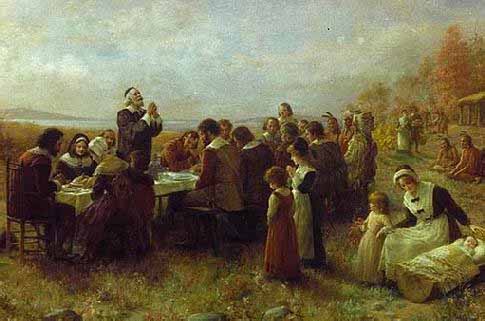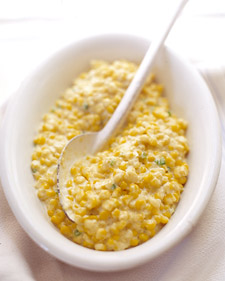
Corn
And all my bones were made of Indian corn.
Delicious grain! Whatever form it take.
To toast or boil, to smother or to bake,
In every dish 'tis welcome still to me,
but most, my Hasty Pudding, most in thee.
In 1796, Joel Barlow (1754-1812), American poet and diplomat, wrote his famous poem called "The Hasty Pudding." The poem was inspired by his homesickness for New England and his favorite cornmeal mush.
Corn is a truly American food. The native Americans farmed it extensively and it was a lifesaver to the first colonists on many occasions. The famous Plymouth pilgrims were able to survive the second year with a plentiful harvest of Indian corn. This was cause for much celebration after the horrific winter previous where half of the people starved to death. Imagine watching whole families die before your eyes and not being able to stop it. Knowing that there would not be another "starving time" must have been amazing. When the harvest finally was in they decided to celebrate the bounty with a day of thanksgiving.

Plymouth historians say the only real description of the feast between the Pilgrims and Indians in 1621 comes from a lone paragraph in a letter from colonist Edward Winslow. It reads:
"Our harvest (of corn) being gotten in, our governor sent four men on fowling, that so we might after a special manner rejoice together after we had gathered the fruits of our labors. They four in one day killed as much fowl as, with a little help beside, served the company almost a week. At which time, amongst other recreations, we exercised our arms, many of the Indians coming amongst us, and among the rest their greatest king, Massasoit, with some 90 men, whom for three days we entertained and feasted, and they went out and killed five deer, which they brought to the plantation and bestowed on our governor, and upon the captain and others. And although it be not always so plentiful as it was at this time with us, yet by the goodness of God, we are so far from want that we often wish you partakers of plenty."
Who can think of the first Thanksgiving without a mental picture of corn.
Corn is an ultimate survival food. It is easy to grow as opposed to other grain crops that require special tools to seed, harvest, and process for storage. Even a child of 4 can plant corn seeds, harvest is even more simple, and drying and storing corn for winter is uncomplicated. In fact the hardest part of producing corn for the settlers was keeping wild animals and birds from stealing most of the crop. Even the stalk of the corn could be used as winter animal fodder. This was something we as modern Amercians tend to underapreciate. Getting in two to three tons of hay for a cow and horse was a huge chore and corn helped offset that labor.
Even after the colonies were well established corn continued to be an important food crop. Corn bread, hoe cakes, Boston Brown Bread, Hasty pudding, Corn meal mush, and on and on became part of our national heritage. Many poor families raised large numbers of children on nothing more than baked beans, corn bread, and milk. One writer commented on the large families when visiting the colonies. He was surprised to see so many children surviving and said "That though these people live in conditions poorer than our own peasants their children survive to adulthood (without starving to death) because of the unvarying diet of corn and beans.
Many pioneers and colonists commented on the dependence they had on corn
In 1662, John Winthrop, Jr., son of John Wilthrop (1588-1649), first governor of the Massachusetts Bay Colony, wrote the following about the pudding in his letter to the royal Society in London. (reprinted in New England Quarterly Vol. X No.1 [1937] p.121-133):
. . . this is to be boyled or Stued with a gentle fire, till it be tender, of a fitt consistence, as of Rice so boyled, into which Milke, or butter be put either with Sugar or without it, it is a food very pleasant. . . but it must be observed that it be very well boyled, the longer the better, some will let it be stuing the whole day: after it is Cold it groweth thicker, and is commonly Eaten by mixing a good Quantity of Milke amongst it. . .
John Josselyn, in his New England Rarities Discovered (London, 1672) also discusses the use of hominy or corn in puddings:
It is light of digestion, and the English make a kind of Loblolly of it to eat with Milk, which they call Sampe; they beat it in a Morter, and sift the flower [flour] out of it; the remainder they call Hominey, which they put into a Pot of two or three Gallons, with Water, and boyl it upon a gently Fire till it be like a Hasty Puden; thye put of this into Milk and so eat it.
Corn was used not only for eating but for heating homes with the cobs out on the treeless plains of the American west. It was the first crop planted in the new cut sod of the great plains. It was a staple food at every meal on the wagon trains and the cabins and sod homes on the western frontier. The cobs were also used as bed stuffing and as insulation within walls. No part of the corn plant was wasted by the new "Yankee Ingenuity"
Without corn America would not be what it is today. Here are a few recipies for corn.
Creamed Corn my way

This is for thanksgiving dinner so it makes allot. Half for a regular dinner.
Two packages frozen white corn (or ten ears sweet corn if in season, cut off kernels with a sharp knife and then use the back of the knife to scrape the cob to get all the "milk" out)
2 cups cream
4 tablespoons butter
salt to taste
1/2 tsp sugar
Combine all ingredients in a large saucepan and simmer until the cream is thick. Serve hot with thanksgiving dinner.
Indian Pudding Recipe - How To Make Indian Pudding
This recipe was shared with me by Mary Wright Huber of Tucson, AZ (formerly of CT and MA). Mary says: "Below you will find my family’s version of Indian Pudding. It is based on an old 1896 Boston Cooking School recipe, which was run by Fannie [Merritt] Farmer. There are many variations of this recipe, some with no spices and some with raisins. One or two even include pumpkin. Although I prefer lots of spices (I am fairly flexible on that issue), and can even see the pumpkin people’s point of view. But I am adamantly anti-raisin! I also think it is a travesty to cook the pudding for less time, at a higher temperature. Many of the newer recipes do this, and I can’t see how one can get the same fine-grained custardy texture. I also think the higher temperatures are likely to form a thick, coagulated layer over the top of the dessert. This recipe takes times and patience, but the reward is great (taste). It not only makes a great dessert (with ice cream), but I have been known to eat it re-heated; with half and half; for breakfast."
3 cups whole milk
1 cup heavy (whipping) cream
1/2 cup yellow cornmeal
1/2 cup light brown sugar, lightly packed
1/2 cup molasses
1 teaspoon salt
2 teaspoons ground cinnamon
1/4 teaspoon ground nutmeg
1/4 teaspoon ground cloves
1/4 teaspoon ground ginger
4 large eggs
4 tablespoons unsalted butter, cut into 4 pieces
Preheat oven to 275 degrees F. Lightly grease a 6- or 8-cup souffle or baking dish with butter (you can use margarine, but DON’T use non-stick sprays).
In a medium-sized saucepan over medium-low heat, scald the milk.
While the milk is heating, pour the cream into a medium to large bowl, add the cornmeal, sugar, molasses, salt, cinnamon, nutmeg, cloves, and ginger. Add this cream/corn meal/spice mixture to the scalded milk. Cook, whisking constantly, over medium-low heat until the pudding has thickened to the consistency of syrup (about 5 minutes). Remove from heat.
In a bowl, beat eggs with a whisk. Temper the eggs by adding 1/2 cup of the hot cornmeal mixture to the eggs while whisking rapidly. Vigorously whisk the egg mixture into the remaining cornmeal mixture. Add butter, one piece at a time, stirring until melted.
Pour mixture into the prepared soufflé dish, and place dish on a shallow baking pan on the center oven rack. Pour enough HOT water into the shallow baking dish to come 2/3 of the way up the outsides of the soufflé or baking dish.
Bake until pudding is set, a tester inserted close to (but not in) the center comes out clean, usually about 2 to 2 1/2 hours. Remove from oven and remove from the water bath and let cool slightly.
Serve warm with vanilla ice cream or whipped cream or heavy cream.
Makes 8 to 16 servings (depending on your sweet tooth).

Love the history of corn! Keep them coming!!!!
ReplyDelete